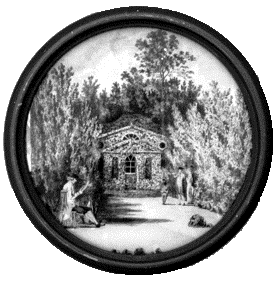John Scott of Amwell facts for kids
John Scott (born January 9, 1731 – died December 12, 1783) was an English writer and a designer of gardens. He was often called Scott of Amwell because of where he lived. He was also the first well-known Quaker poet. Quakers are a Christian group known for their peaceful beliefs. Today, he is mostly remembered for one poem that spoke out against war.
Contents
John Scott's Life Story
John Scott's father was a successful clothing seller in London. Later, his family moved to Amwell House in a village called Great Amwell in Hertfordshire. There, his father worked as a maltster, someone who prepares grain for making drinks. The family were Quakers. John's older brother, Samuel, became a Quaker minister.
John stayed at home and began improving the gardens around Amwell House in 1760. He designed them to be like the famous gardens of William Shenstone. The most special part of his garden was a grotto, which is a cave-like structure. It had six underground rooms covered with flints, shells, and minerals.
His poem "The Garden" described his ideas for a natural-looking garden, not a formal one. Even the famous writer Samuel Johnson visited and said, "none but a poet could have made such a garden." The grotto was a popular place for visitors for many years. It was restored in 1991 and is now seen as a great example of grotto art.
John Scott did not have a full or easy education. He learned about poetry from a bricklayer who taught himself. John later married the bricklayer's daughter, Sarah Frogley, in 1767. Sadly, she died the next year during childbirth. In 1770, he married Maria De Horne, and they had a daughter, also named Maria.
Scott's Writings and Public Work
In 1773, John Scott published a book called Observations on the present state of the parochial and vagrant poor. This book criticized the old laws about helping poor people. Even though his ideas were liked, they did not become law.
He was also known as an expert on turnpike roads, which were roads where you had to pay a fee to use them. He wrote about them in 1773 and again in 1778. His book was later praised by many. He was an active member of three turnpike groups in Hertfordshire. He also wrote a political pamphlet called “The Constitution Defended.” This was a response to a paper by Samuel Johnson.
John Scott often visited London starting in 1760. There, he met John Hoole, who introduced him to Dr. Johnson. Even though they had different political views, Johnson said he "loved Mr Scott." Johnson even planned to write about Scott's life, but he died before he could.
Scott himself died in 1783 from a fever he caught during a visit to London. After his death, his book Critical essays on several English poets was published in 1785. It also included a story about his life written by John Hoole. Scott had written these essays because he disagreed with some of Johnson's writings about poets.
John Scott's Poetry
John Hoole described how Scott wrote his poems. After his family went to bed, Scott would often sit in a dark room. When he had thought of many lines, he would go to another room with a candle to write them down.
His first published poems were "Four Elegies descriptive and moral" in 1760. These poems described the changing seasons. Dr. Johnson did not like this kind of poetry very much.
It wasn't until 1776 that Scott published "Amwell, a descriptive poem." This poem was written in blank verse, which means it didn't rhyme. In it, Scott wrote about how the countryside he knew as a child brought him joy. After this poem, he became known as Scott of Amwell.
Later, he published his "Moral Eclogues" (1778). Soon after, his collected Poetical Works came out in 1782. This collection was reprinted several times. The book also included drawings by the young artist William Blake.
Scott's poems often described things in great detail, unlike some earlier poets. For example, he wrote about specific plants:
-
- There spread the wild rose, there the woodbine twin'd;
- There stood green fern, there o'er the grassy ground
- Sweet camomile and ale-hoof spread around;
- And centaury red, and yellow cinquefoil grew,
- And scarlet campion and cyanus blue;
- And tufted thyme, and marjoram's purple bloom,
- And ruddy strawberries yielding rich perfume.
His poems also showed a wide knowledge of literature and different places. He wrote poems inspired by Mark Akenside and a sonnet about William Shenstone. His poem “Mexican Prophecy” was set during the Spanish conquest of the Aztec Empire. In his “Oriental Eclogues,” he wrote three poems set in Arabia, India, and China. The one about China was about the historical poet Li Po.
Scott felt that not all his poems were included in his Poetical Works. Twelve poems that were not published are still found among his papers or in letters to friends.
The Drum: A Famous Anti-War Poem
The poem John Scott is most remembered for today is “The Drum” (Ode 13). It is a strong anti-war poem that begins, “I hate that drum’s discordant sound.” This poem was printed many times after it was first published.
In England, Benjamin Frankel set it to music in 1959. Later, Christopher Dowie also set it to music. In the 21st century, the Quaker composer Ned Rorem used it as the first song in his cycle "Aftermath" (2001). This was a peaceful response to the feelings of revenge after the attacks of 9/11. Other musicians in the US and Canada have also set "The Drum" to music.



